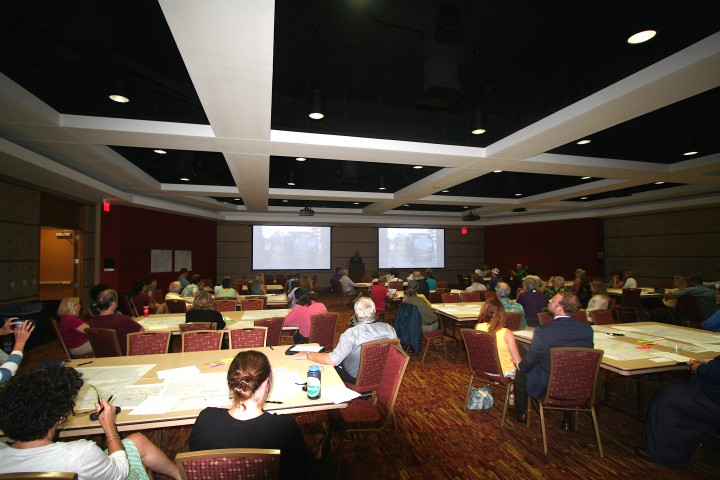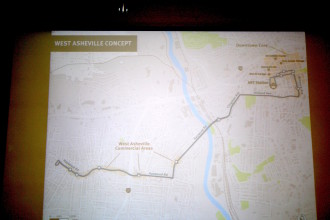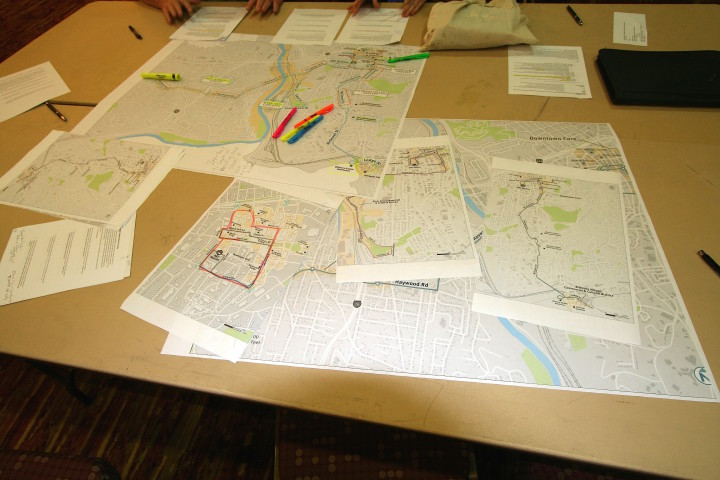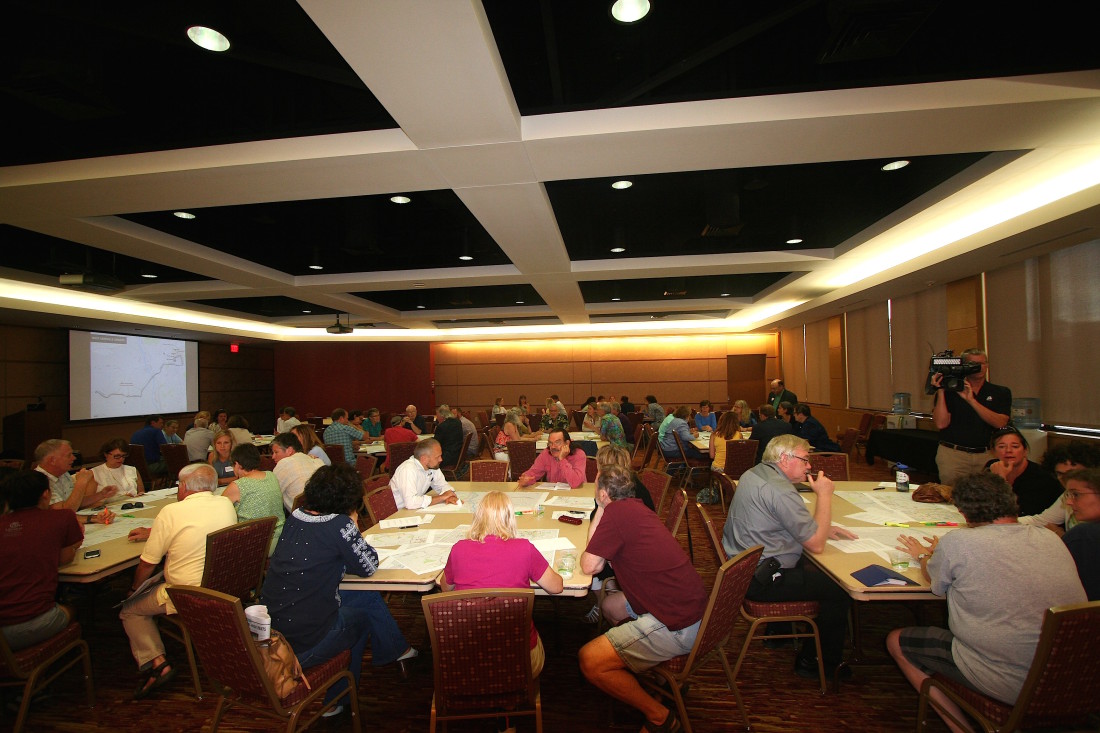Scores of Asheville residents met with city staffers and representatives from Nelson Nygaard, a national transportation consulting firm, on Wednesday, August 17 to learn about and provide feedback on an early-stage proposal on instituting a city shuttle service in and around downtown Asheville.
The workshop was kicked off by Asheville transportation director Ken Putnam, who said that the shuttle service is being looked at as part of a wider parking study being conducted by the city. He emphasized that the night’s meeting was the first in an ongoing look at what such a service around the central business district might work.
“Nothing is set in stone,” Putnam said. “These are just concepts, which will give us an idea of the start-up and annual costs [of the shuttles].”
Larry Gould, a principal with Nelson Nygaard, offered a short presentation of the company’s initial sketch of shuttle routes, based on early observations of traffic patterns and infrastructure around the city.
“This is a sample of root ideas,” he said, adding that community input would be a valuable tool to altering and updating the prospective routes and finding the best options for serving locals and visitors. “We want feedback, ideas of adjustments and modifications. Everything we’ve done gets better with community feedback.”
His presentation began with an explanation of what a shuttle, or circulator, system is: short transit routes with direct destinations, serving specific purposes. “It’s meant to help fill in the gaps within the existing transit system,” Gould explained, “and allow [Asheville Redefines Transit] to work faster.”
Nelson Nygaard and the city also hope such as system might help alleviate parking and congestion issues downtown by fostering a sort of park and ride system, where downtown commuters could catch a shuttle at parking decks and lots, instead of competing for parking space on the street.
Gould suggested that such a system, if implemented, should be free for riders, perhaps in connection with ART fares and rates. “It takes time to collect fares,” he said. “A fast system is more attractive to riders.”

Early examples
Initial sketches of possible routes were broken down into three phases of implementation, which would allow the city to manage costs and implement the shuttle system in stages. Phase one would function as a base or “starter” system, Gould said, with limited service restricted to the downtown area.
The downtown ART station would serve as a central hub for the shuttle service. From there, the shuttles would include stops at most downtown parking decks as well as popular streets and attractions like the Grove Arcade and civic buildings.
According to Nelson Nygaard’s initial sketch, the downtown shuttle route would operate on an estimated 2.1 mile route, with an average round trip time of 19 minutes. Shuttles would run between 7 a.m.-9 p.m., Monday through Friday, and 10 a.m.-7 p.m., Saturday and Sunday.
Phase two would expand the existing downtown route to incorporate service to Mission Hospital and possibly Biltmore Village via McDowell Street, which Gould said would help serve patients needing transportation to the hospital campus, as well as Mission employees. He noted that the exact route could change, based on community response and traffic patterns.
Phase two’s route would run an estimated 6.7 miles for a 41 minute round trip. Operating times could range from 10 a.m.-7 p.m. on a continuous route or be broken into shifts from 7-10 a.m. and 7-11 p.m.
Gould explained that his company had shied away from using Biltmore or Hendersonville Road for the phase two route due to heavy congestion on those thoroughfares.
Phase three, meanwhile, would explore additional routes to and from the River Arts District and Haywood Road in West Asheville, with designated stops at popular businesses and studios and extended evening hours on weekends.
Nelson Nygaard presented two alternatives for routes to the RAD:
- Option one would connect the ART downtown station to the RAD, with stops at popular studios and businesses like The Wedge Brewing Company. The route would end at a lot south of the Magnetic Theatre on Depot Street, with an estimated length of 4.6 miles and a run time of 25 minutes.
- Option two would function on the same concept, but end at the Dr. Wesley Grant Sr. Southside Center on Livingston Street, encompassing a 5.2 mile route over 28 minutes. Option two would also offer two shuttles running simultaneously, as opposed to one shuttle under option one.
Phase three of the shuttle service could also include a separate connection to the commercial business sector along Haywood Road in West Asheville, with the route possibly ending at the intersection of Haywood and Vermont Avenue. Gould explained that there would be few stops between the downtown ART Station and Haywood Road, as the focus would be on getting commuters to and from West Asheville.

The West Asheville shuttle would offer extended evening hours on weekends to serve residents going out for a night on the town as well as employees of restaurants and businesses along Haywood Road who work late into the evening.
Cost and community input
Next, Gould presented several options for the types of vehicles that would serve as shuttles, drawing on examples from other cities’ systems, such as Louisville, Kentucky, Chattanooga, Tenn. and Cleveland, Ohio.
Shuttle options ranged from state-of-the-art, expensive electric buses to traditional transit-type models and more affordable “cutaway” buses that are built on truck chassis. While the smaller, simpler models would cost less, they would also have a shorter service life. Gould said the city and community would have to decide which option would strike the best balance between affordability and efficiency.
Nelson Nygaard’s breakdown on the estimated annual costs of the various routes were as follows, with the low estimates for each based on running smaller shuttles,and higher end options reflecting larger vehicles with commercially-licensed drivers, similar to a traditional transit system.
Phase One:
- Downtown: $227,000 – $363,000
Phase two:
- Biltmore/Mission: $748,250 – $1,197,000
Phase Three:
- RAD Option 1: $127,750 – $204,400
- RAD Option 2: $255,500 – $408,800
- West Asheville: $514-950 – $823,920
Costs would also depend on the type of vehicle used, the exact route chosen and the hours of operation for each route.
Following Gould’s presentation, attendees broke into groups to go over the potential routes and stops for each phase and offer suggestions, voice concerns or propose alternatives. City staff members facilitated each group, and a spokesperson presented each table’s ideas following the half-hour workshop period.

Common sentiments expressed by many groups included extending service to outlying parking areas and to hotels on Tunnel Road, A-B Tech (on weekends) and Westgate; ensuring that downtown and surrounding neighborhoods would be properly and comprehensively covered by the routes; and avoiding duplication of ART’s existing services.
A few attendees questioned why a shuttle service was being considered instead of applying funds to improving ART’s services, while others encouraged Nelson Nygaard and the city to consider offering service to amenities locals could benefit from, such as shopping centers and grocery stores, instead of designing routes primarily around downtown and tourist needs.
Gould said that all opinions and suggestions would be examined closely by his company moving forward. “We’re going to go through these with a fine-toothed comb,” he noted. Participants in the workshop also filled out questionnaires, which city staff will compile along with the maps and pass on to Nelson Nygaard for analysis.
According to Putnam, the comprehensive parking study —which includes the shuttle proposal — is expected to be completed by mid-September. However, Putnam adds that the shuttle review is meant to provide estimates on the up-front and annual operating costs of such a program, and that there are no immediate plans to move forward on it in the near future.








Let’s make it an ART route that’s aimed specifically at tourists — getting them to Tunnel Road hotels, or from downtown to the RAD and West Asheville and back again — and run it frequently and then get it funded by the TDA from the hotel tax, because it’s for tourists. If it happens to benefit city residents, then whoopee, the hotel tax is finally going somewhere it ought to go.
LOL, they extort residents by the millions around here. What makes you think their friends will want to change?
Sounds good to me, lol. Why do we need to be spending money on crack dealers in low-income housing in West Asheville?
Because the crack dealers in Biltmore Forest charge a lot more.
And they’re always trying to get you to take over their white-elephant timeshare.
Dedicated TDA funding is an excellent idea. They have so much money from the increased hotel tax, they don’t know what to do with it.
I wonder if anyone suggested it at this meeting?
This idea was actually mentioned by one of the groups as a possibility for funding the shuttle program. Thanks for bringing it up!
Thanks Max. I hope they seriously consider it.
Spend us into oblivion!! Yes we helped .2% of the population at an enormous cost!! I love being progressive, quick to the money tree!!! Debt is a hate word!